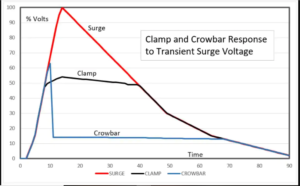
Embedded electronics, the Internet of Things (IoT), and machine-to-machine (M2M) connections have become widespread in diverse areas, so it is important to protect interface connections from overvoltage conditions and transient events that can cause damage (Figure 1):
- Overvoltage conditions can last seconds to minutes, or longer.
- Transient events happen in a short time—tens to a hundred microseconds during an industrial switching or lightning transient event, down to a few nanoseconds with an electrostatic discharge (ESD) transient.

Protection Devices
Several devices can be useful to protect power, signal, and communication interfaces from damage involving destructive transient voltages. Two common types of protection circuits may employ
(1) clamp-circuit devices
(2) crowbar-circuit devices
- Clamp devices are mainly useful to protect current limited power connections.
- Crowbar devices can protect current limited power lines as well as data and signal lines.
When choosing protection devices for power and signal connections an engineer must consider the fit of the application with the various options of clamps, crowbars, silicon, and ceramic devices (Table 1). Let’s examine these options in more detail.
Table 1: The decision to use clamps or crowbars also depends on the device materials.

Clamp Devices
Clamps will conduct enough current to maintain the voltage across it at a safe, specified value when the transient is above the conduction voltage. It receives a rating according to the power it can dissipate for a specific time. The protection device needs a rating for the power to dissipate during the transient event. The voltage across the load rises only slightly above the rated clamp voltage during the maximum surge voltage. An example is the Bourns ChipGuard MLA μVaristor Series ESD Clamp Protectors which are developed especially to protect sensitive automotive electronics from the threat of ESD up to IEC 61000-4-2 Level 4.
- The Transient Voltage Suppressor (TVS) is a silicon clamp device with breakdown voltages from 4 to 500V within various power ratings, providing different surge protection capabilities. It is a bipolar junction, similar to rectifier diodes, designed to survive a reverse breakdown. An example includes the Bourns CDSOD323-TxxC-DSLQ AEC-Q101 TVS Diodeswhich are transient voltage suppressor diodes for surge and ESD protection in a SOD323 package.
- The Metal Oxide Varistor(MOV) is a ceramic clamp device with breakdown voltages from 14 to 1400V and capable of 6.5kA in an 8/20µs lightning-surge waveform.
Crowbar Devices
A crowbar device trigger occurs at a voltage above the protection voltage. The device protects by applying a low impedance across the protected load when an overvoltage condition triggers it. The device stays in the low impedance state until the current decreases below the holding current and the device returns to the high impedance state. In the low impedance state the device conducts the current that the external circuit limits. In this way, the voltage flowing across the protected device stays low. Ultimately, the crowbar protection device acts as the low impedance device on the low voltage side of a voltage divider, keeping the high voltage in the external circuit and protecting the sensitive load on the low voltage side.
- Thyristor Integrated Surge Protectors (TISP)are PNPN-based silicon semiconductor crowbar devices. Their breakdown voltages can be set precisely, and they are available in many package types to dissipate various surge levels.
- Gas Discharge Tubes (GDT) are ceramic crowbar devices enclosing a spark gap that conducts a high-current arc upon the trigger of a high-voltage, high-current source, such as lightning, with an example being the Bourns 2003 Gas Discharge Tube Surge Protector.
Summary
Protecting interface connections from overvoltage conditions and transient events is more important than ever with the proliferation of embedded electronics.
Bourns clamp and crowbar protection devices are effective at protecting circuit interfaces within silicon and ceramic electronic components. For more information, visit the Bourns site at Mouser.com.


















